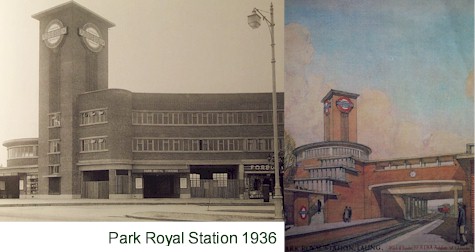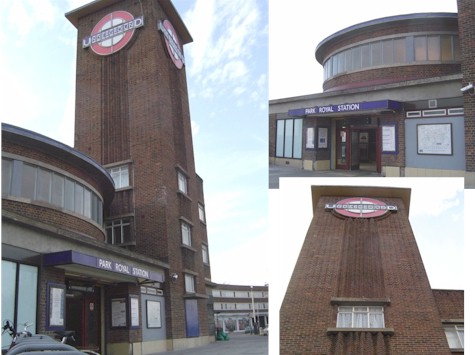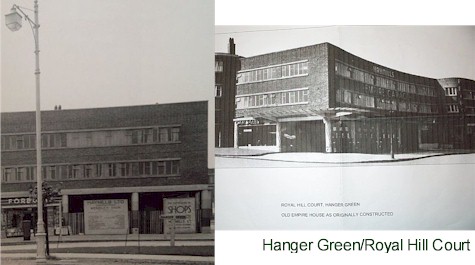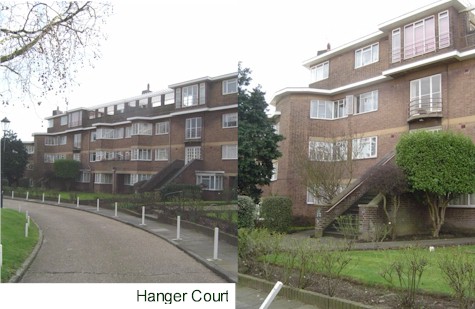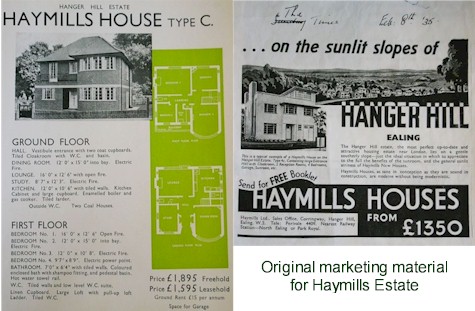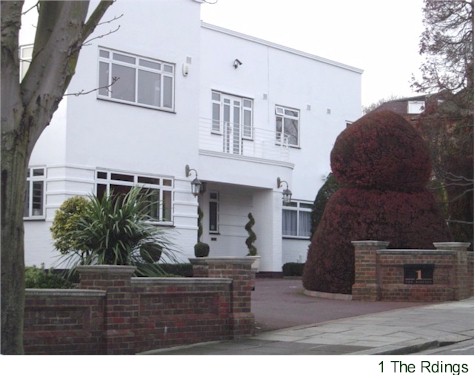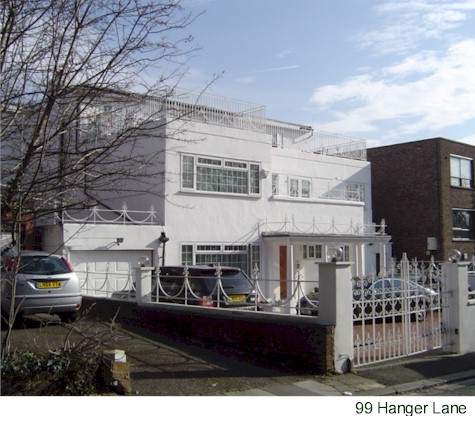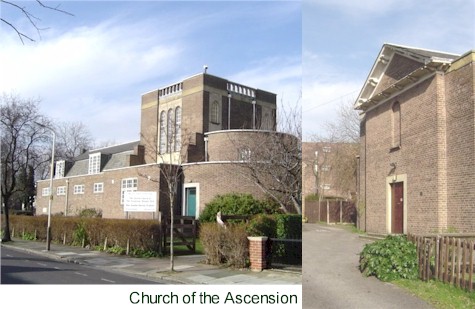
Open House Walking Tour
- Walking Tour of the Hanger Hill (Haymills) Estate - Open House Day
- INTRODUCTION
This one-hour tour of the estate, starting at Park Royal tube station, and walking past public buildings on the estate, typical houses, including modern movement ones and ending at the Church of the Ascension, was part of the Open House event in September 2005.
Bob Gurd, Chairman of the Hanger Hill (East) Residents’ Association and Ealing Civic Society, shares the tour.
BACKGROUND
The estate was developed by Haymills and designed by a single firm of architects -- Welch, Cachemaille-Day and Lander. Built on the site of Hanger Hill House, home of the Wood Family who owned large tracts of Ealing.
Between 1901-1930 it was leased to become the headquarters of the Hanger Hill Golf Club but in 1927 was sold to Messrs Haymills for residential development. The estate was designed around concentric crescents in order to follow the contours of Hanger Hill.
Architects

Herbert Arthur Welch
(1884-1953)started his career as one of the architects involved with the Hampstead Garden Suburb. Formed partnership in 1928 with Cachemaille Day and advised Haymills on their planning of the estate.
Nugent Francis Cachemaille-Day
(1896-1976)worked on Welwyn Garden City. He was involved extensively on churches from the early 1930s (indeed designed a Church nearby in Twyford Abbey). After 1935, he was no longer associated with Welch and Lander.
Felix Lander
(1898-1960)trained at Letchworth Garden City and later at Welwyn Garden City. Briefly worked with Charles Holden (of London Transport fame). This might explain the Park Royal connection. Lander was an outstanding draughtsman.
Park Royal Station
Welch & Lander - 1935/36 (1 ON MAP)
This was the focus of the estate. Messrs Haymills, builders, decided to offer part of the estate free to London Transport for the new station. It was designed to be at the convergence of several roads, including the then new arterial road of Western Avenue.
They also wanted to harmonise with the rest of the estate i.e. by using their own architects rather than London Transport's. The result is in line with the general concept of Holden but Welch and Lander designed it.
Features include a circular booking hall, which is a Holden concept. The structure is built of reinforced concrete with brick infill. The booking hall itself consists of a cantilever construction tied in with rings supporting the dished roof.
The bridge and stepped staircases are also of reinforced concrete. The best views are from the platforms or from the path to the south of the station.
Park Royal Hotel
PARK ROYAL HOTEL (WELCH, LANDER, CACHEMAILLE-DAY 1936) (2 ON MAP)
Originally built by Haymills for Messrs Barclay Perkins - brewers. It avoided being a "Tudorbethen" public house so common in other inter-war hotels and roadhouses.
It originally had warm coloured wood veneers, bronze fittings etc. but all the original fittings have been removed. The first-floor had a meeting room for the estate. The spiral brick piers are an interesting feature but were not originally painted. The garage (closed 1999) and offices above were converted into a shop and flats in 2003/04.
Hanger Court
HANGER COURT (WELCH, LANDER, CACHEMAILLE-DAY -- 1935) (3 ON MAP)
The convex circle of shops on Hanger Green contrasts with the concave aspect of 30 flats with a jagged outline punctuated by many bay windows.
The windows have been replaced, but the newer metal windows are in keeping with the originals. The doors are original. The rear elevation with its tall staircase towers is of interest. There are similar flats at Barn Hill, Wembley but are less well preserved.
The flats look over the Park Royal Brewery site -- currently subject to redevelopment which has lead to the demolition of the original brewery buildings by Sir Giles Gilbert Scott (1933/35) who was also involved at the former power stations and Battersea and Bankside.
Walk up Heathcroft to The Ridings (SEE MAP) to see some typical house designs of the period.
WALK UP HEATHCROFT TO THE RIDINGS (NO 37)
This is one of the few blue plaques commemorating scientists. Alan Dower Blumlein was a 1930’s pioneer of telecommunications, television and radar. He developed with Colombia Gramophone Company, a new method of recording electronically which he subsequently turned into a stereophonic means of recording sound.
Recordings exist to this day of Blumlein and his assistant walking around a room ("Walking, Talking record"). He went on to develop stereophonic films shot near the former HMV factory in Hayes. He developed many of the fundamental features of television with EMI -- it is said that the former 405-line system was invented one weekend in this house.
He was a very inventive man and some wartime stories relating to this house are testimony to this. Tragically, he was killed in 1942 in a plane crash in Wales when he was developing a radar system (H2S) which went on to be used extensively to assist bombers on raids over Germany.
THEN WALK DOWN THE RIDINGS TO JUNCTION OF DALLAS ROAD-THE RIDINGS
This road contains many of the best of Welch and Lander houses dating from 1936, although some are sadly very altered. No 1 the Ridings (5 ON MAP) was one of the first modern movement houses built on the estate. It is the largest house with the largest plot and is more like a country house with a service yard and originally had a tennis court and orchard. The nautical sunroom gives a modern touch to be otherwise classical treatment. The house was intact, with all its original fixtures and fittings (including fitted furniture), until 1985. Unfortunately attempts to list it failed.
The windows were changed in around 1990, fortunately in a style, which is sympathetic with the original house unlike many others on the estate. The estate itself was declared a conservation area in 1996 with an Article 4 Direction (limiting changes to front elevations) in force since 1997.
Walking up Dallas Road and down Chatsworth Road to Hanger Lane, you pass a number of modern movement houses, including 99 HANGER LANE (RADICALLY CHANGED) (6 ON MAP)
CHURCH OF THE ASCENSION, BEAUFORT ROAD (Seely and Paget, 1939)
(7 ON MAP)
This is a small Church, seating three hundred and fifty people. It has Italianate eaves at the Western end. Other windows and roof shapes are of classical style-- the curved brick of the chancel wall suggests a comparison with Park Royal station. The shadowy nave leads into a brilliantly lit chancel looking on to the alter steps and simple rood beam. Alan Durst carved the wooden figures in 1946 as a war memorial.
The chancel joinery is particularly fine, with two-tone wood rather reminiscent of late Lutyens. There is also an early Compton electronic organ dating from 1947, which is still in working order. John Compton lived nearby on the estate.
Seely and Paget were well known for the remodelling of Eltham Palace for the Courtaulds in the 1930s. The Courtaulds have an Ealing connection because they financed the construction and running of Ealing Studios for many years. Unfortunately, the architects managed to design in several faults into the building, including leaking flat roofs and exposed parapet walls.
